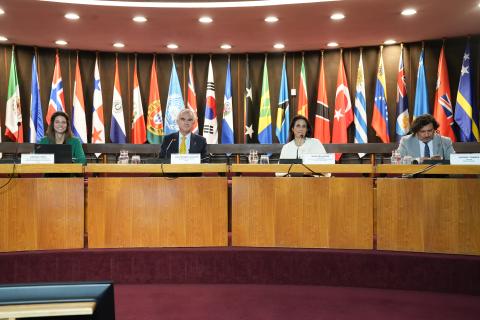Press Release
A new book published by the Economic Commission for Latin America and the Caribbean (ECLAC) analyzes the macroeconomic dynamics in the region’s countries through the study of their social, institutional and productive structures, and proposes rethinking macroeconomic policy with the aim of prioritizing productive development.
The publication Productive Structure and Macroeconomic Policy: Heterodox Approaches from Latin America (only available in Spanish) brings together eight articles penned by a total of twelve authors and edited by the Executive Secretary of ECLAC, Alicia Bárcena; the Deputy Executive Secretary, Antonio Prado; and the Director of ECLAC’s Office in Buenos Aires, Martín Abeles.
The first two chapters seek to identify the most relevant dimensions for the macroeconomic analysis of developing countries. The remaining work is centered on three core themes: the region’s monetary policy, the relationship between the real exchange rate and growth, and the determinants of inflation and the policy options that exist to stabilize it.
According to the prologue written by Alicia Bárcena, from the structuralist perspective in which ECLAC is steeped, the functioning of the region’s economies should be understood as the result of historical processes that have given rise to a certain structural and institutional configuration, a factor that the dominant school of economic thought rarely considers.
In the case of Latin America and the Caribbean, these determinants have meant that in recent decades the region has repeatedly confronted the obstacles stemming from its international insertion as a provider of raw materials and the tensions associated with its growing international financial integration, which has allowed countries to access external credit but has simultaneously exposed them further to the cycles of international liquidity.
In this analytical framework, ECLAC has worked to construct macroeconomics for development, which seeks not only stability in certain macroeconomic variables but also productive development and social inclusion. In this book, all of the chapters present outcomes—analytical or empirical—that strive to flesh out that relationship and that challenge the standard or conventional approach in one way or another.
The book offers the possibility of rethinking the adaptation of the region’s predominant macroeconomic policy focuses and proposing that this policy be coordinated with productive, labor and social measures to promote a structural change with equality and environmental sustainability.
The authors of the book’s chapters participated in the First Seminar-Workshop on Productive Structure, Institutions and Economic Dynamics in Latin America, which was held in April 2014 at ECLAC’s Office in Buenos Aires. They include the Director of that Office, Martín Abeles, and other specialists from the United Nations regional organization: Sebastián Valdecantos, Esteban Pérez Caldentey and Daniel Vega.
Other collaborators on the book include Edgardo Torija Zane, an economist at the United Nations Conference on Trade and Development (UNCTAD); Ariel Dvoskin and Luis Trajtenberg, professors at the University of Buenos Aires; Demian Panigo, Director of the Argentine Workers’ Center for Innovation; Gonzalo Bernat, a researcher at Fundación CREAR; Juan Carlos Moreno Brid, a professor at the National Autonomous University of Mexico and a former ECLAC official; and Luis Ángel Monroy Gómez Franco, a Master’s candidate at the College of Mexico.



